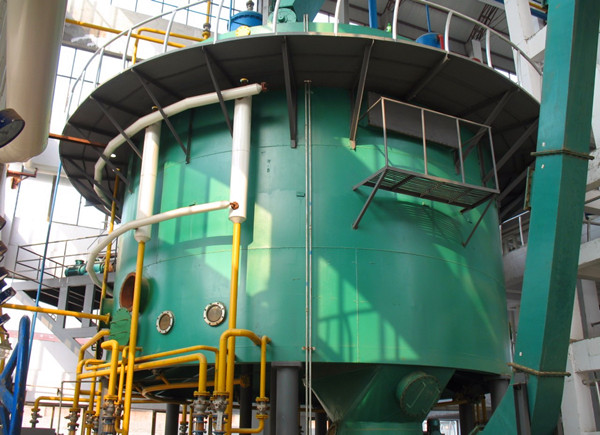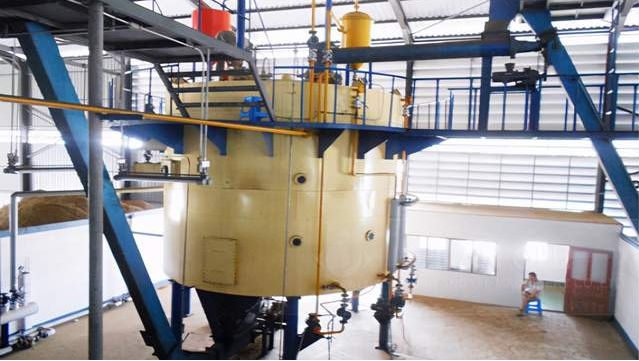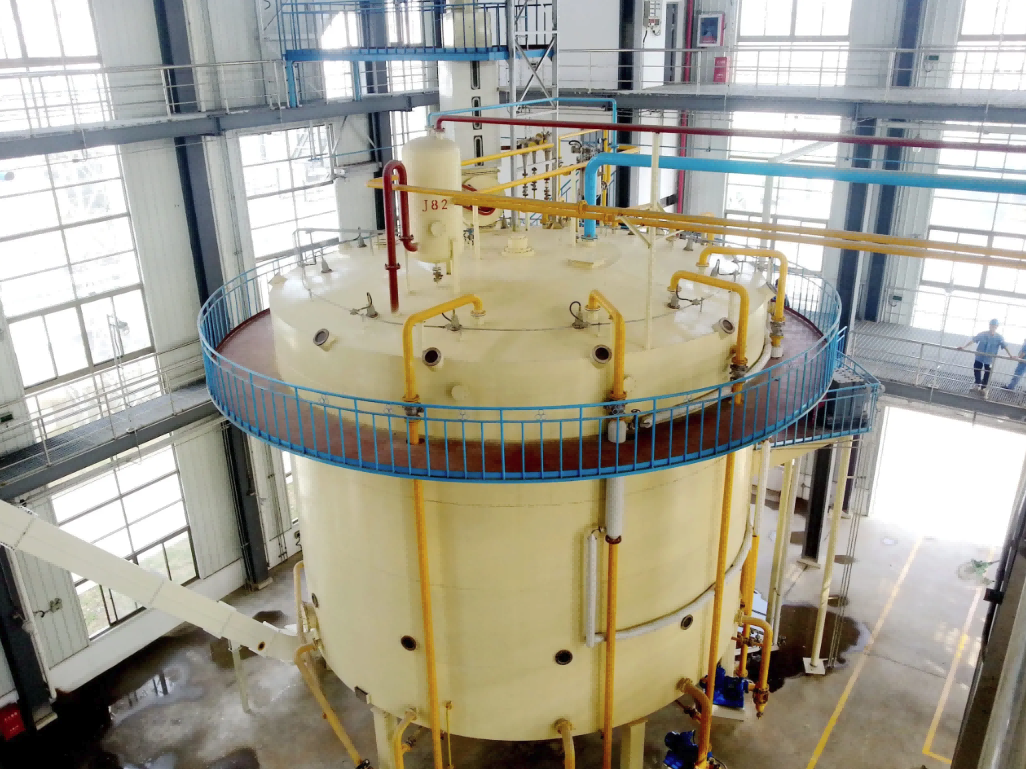1. The basic process of oil production by leaching method:
Oil production by leaching method is based on the principle of extraction. An organic solvent that can dissolve grease is selected. After contact with the oil (soaking or spraying), the grease in the oil is extracted. Oil method. The basic process is: immerse the oil embryo (or pre-pressed cake) in the selected solvent, dissolve the oil in the solvent (composition of mixed oil), and then separate the mixed oil from the solid residue (meal), and press the mixed oil again. Different boiling points are evaporated and stripped, so that the solvent is vaporized into vapor and separated from the oil, thereby obtaining grease (extracted crude oil). The solvent vapor is condensed, cooled and recovered, and then reused. The meal also contains the required amount of solvent. After desolventizing and drying, the dried meal is obtained. The solvent vapor volatilized during the desolventizing and drying process is still condensed and cooled for recycling.
2. Advantages of oil production by leaching method:
Oil production by leaching method has the advantages of low residual oil rate in meal (high oil yield), low labor intensity, good working environment and good meal quality.
It can be seen that, compared with the squeezing method and the leaching method, oil production is indeed a kind of oil production method, and it has been widely used at present.
3. The basic principle of oil leaching:
Oil leaching, also known as "extraction", is the process of extracting oil from oil with organic solvents. The leaching of oil can be regarded as solid-liquid extraction, which is a process of separating the relevant components in solid materials by using the properties of solvents to have different solubility for different substances. During leaching, the oil is treated with a solvent, and the easily soluble components (mainly grease) are dissolved in the solvent. When the oil is leached in a static state, the oil is transferred in the form of molecules, which is a "molecular diffusion". However, the leaching process is mostly carried out with relative movement between the solvent and the pellets. Therefore, in addition to molecular diffusion, there is also a "convection diffusion" process that depends on the flow of the solvent.

4. Oil-making process by leaching method
(1) The classification of the leaching method of oil production process. According to the operation mode, the leaching method of oil production process can be divided into intermittent leaching and continuous leaching:
① Intermittent leaching: the raw material enters the extractor, the meal is discharged from the extractor, the injection of fresh solvent and the extraction of concentrated mixed oil are all batch, intermittent, and periodic leaching processes that belong to this process. Types of.
② Continuous leaching: the raw material enters the extractor, the meal is discharged from the extractor, the injection of fresh solvent and the extraction of concentrated oil are all continuous leaching processes belonging to this process type.
(2) Oil-making process by leaching method According to the production method, it can be divided into direct leaching and pre-expression leaching:
① Direct leaching Direct leaching is also called "one-time leaching". It is the process of leaching the oil directly after pretreatment of the oil. This process is suitable for processing oil with low oil content.
② Pre-squeezed leaching The pre-squeezed leaching oil is pre-squeezed to remove part of the fat, and then the cake with higher oil content is leached. This process is suitable for oils with higher oil content.
(3) The selection basis of the leaching process and the basic process flow Whether the leaching production can proceed smoothly is closely related to the selected process flow, and it directly affects the product quality, production cost, production capacity and operating conditions of the oil plant after it is put into production. Many aspects. Therefore, an excellent and reasonable process flow should be adopted. The basis for selecting the process flow is:
① Choose according to the variety and nature of raw materials
Such as processing cottonseed, the process flow is: cottonseed→cleaning→delinting→peeling→separation of kernel and shell→softening→embroiding→steaming and frying→pre-pressing→leaching;
If processing rapeseed, the process flow is: rapeseed → cleaning → rolling embryo → steaming and frying → pre-pressing → leaching;
According to the different oil content of raw materials, determine whether to use one-time leaching or pre-pressing leaching. As mentioned above, rapeseed and cottonseed kernels are all high-oil raw materials, so the pre-press extraction process should be used. However, the oil content of soybeans is low, so a one-time leaching process should be used. Soybean → cleaning → crushing → softening → rolling embryo → drying → leaching;
② Choose according to the requirements of products and by-products. The requirements for products and by-products are different, and the process conditions should also be changed accordingly. For example, soybeans are also processed and soybean meal is used to extract protein powder. Soybeans are required to be dehulled to reduce crude fiber. The content of protein, relatively speed up the protein content, the process flow is: soybean→cleaning→drying→temperature adjustment→crushing→dehulling→softening→rolling embryo→leaching→leaching meal→baking→cooling→crushing→high protein soybean meal
③ Choose according to production capacity. Oil plants with large production capacity can choose more complex processes and equipment; oil plants with small production capacity can choose relatively simple processes and equipment. For example, a leaching workshop with a daily processing capacity of more than 50 tons may consider adopting a paraffin oil exhaust gas absorption device and a refrigerated exhaust gas recovery solvent device.

(1) Process flow: raw material (or pre-pressed cake) → storage box → enclosed auger → (solvent →) extractor (→ wet meal) → mixed oil
The raw material or pre-pressed cake formed by the pretreatment of the oil is sent to the extractor by the conveying equipment, and the concentrated mixed meal and wet meal are obtained after being leached by the solvent.
(2) Extraction equipment: The important equipment of the extraction system is the extractor, which has many forms.
Intermittent leaching device-leaching tank; continuous leaching device-flat-rotating leaching device, annular leaching device, drag chain leaching device, etc.
6. Desolventizing and drying of wet meal
(1) Process flow: wet meal → scraper conveyor → steamer (→ meal catcher → mixed steam) → dry meal (cooling) → warehouse;
The meal discharged from the extractor contains 25%-35% of the solvent. In order to recover these solvents and obtain better quality meal, heating can be used to evaporate the solvent.
(2) Desolventizing drying equipment, the desolventizing drying of the leached meal from the pre-pressed cake mostly adopts a high-layer steamer, and the desolventizing and drying of the soybean dregs once should adopt D. T steam offline.

7. Evaporation and stripping of mixed oil
(1) Process: mixed oil filtration → mixed oil storage tank → d long tube evaporator → second long tube evaporator → stripping tower → leaching crude oil;
The mixed oil (a solution composed of grease and solvent) pumped from the extractor must be treated to separate the grease from the solvent. The separation method is to use the different boiling points of the grease and the solvent. At first, the mixed oil is heated to evaporate, so that most of the solvent is vaporized and separated from the grease. Then, using the difference in volatility between oil and solvent, the concentrated mixed oil is steam distilled (that is, steam stripping), and the residual solvent in the crude oil is distilled out, so as to obtain the leached crude oil with very low solvent content. Before evaporation and steam stripping, the mixed oil must be "pretreated" to remove the solid meal and colloidal substances in it, and create conditions for the separation of the components of the mixed oil.
(2) Filter, let the mixed oil pass through the filter medium (screen), and the solid meal contained in it will be intercepted to obtain a cleaner mixed oil. In the flat-transformation extractor with larger processing capacity, a tent-type filter is installed on the second oil collecting grid. The filter screen is 100 mesh. The concentrated mixed oil is filtered and then pumped out.
(3) Centrifugal sedimentation. Nowadays, a hydrocyclone is often used to separate the coarse powder in the mixed oil. It uses the different weights of the components of the mixed oil, and uses centrifugal rotation to generate the difference in centrifugal force, so that the meal powder sinks and the liquid rises. , To achieve the purpose of cleaning the mixed oil.
(4) Evaporation of mixed oil. Evaporation is the use of heating to vaporize a part of the solvent in the solution, thereby accelerating the concentration of the solute in the solution, even if the volatile solvent is separated from the non-volatile solute. The evaporation of the mixed oil is a process in which the oil is almost non-volatile, and the solvent has a low boiling point and is easy to volatilize. Heating is used to vaporize most of the solvent, thereby greatly accelerating the concentration of the oil in the mixed oil. In the selection of evaporation equipment, oil plants often use long tube evaporators (also called "rising film evaporators"). Its characteristic is that the heating pipe is long, the mixed oil enters the heating pipe from the lower part after being preheated, and boils quickly, producing a large amount of vapor bubbles and rising rapidly. The mixed oil is also driven by the rising vapor bubbles and drawn as a liquid film that rises along the pipe wall, and the solvent continues to evaporate in the process. Since heat is transferred in a thin film state, the evaporation efficiency is higher. The equipment is a long tube evaporator.
(5) In the stripping of the mixed oil, the concentration of the mixed oil is greatly accelerated by evaporation. However, the boiling point of the solvent also increases. Regardless of whether the normal pressure evaporation is continued or the reduced pressure evaporation is changed, it is quite difficult to basically remove the remaining solvent in the mixed oil. Only by steam stripping can the residual solvent in the mixed oil be basically removed.
Steam stripping is steam distillation. The principle is that the mixed oil and water are not compatible. Direct steam that needs pressure is passed into the concentrated mixed oil with a high boiling point. At the same time, indirect steam is passed into the jacket of the equipment for heating. Direct steam into the mixed oil will not condense. The sum of direct steam and solvent vapor pressure balances with the external pressure, and the solvent boils, thereby reducing the boiling point of the high boiling point solvent. The uncondensed direct steam entrains the distilled solvent into the condenser for condensation and recovery. Its equipment includes tubular stripping tower, layered dish stripping tower, and inclined plate stripping tower.
Copyright © Henan Zhongxing Grain And Oil Machinery Co.,Ltd. All Rights Reserved. Powered by MetInfo